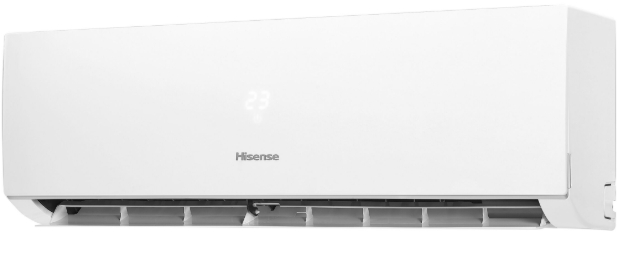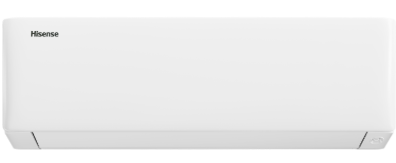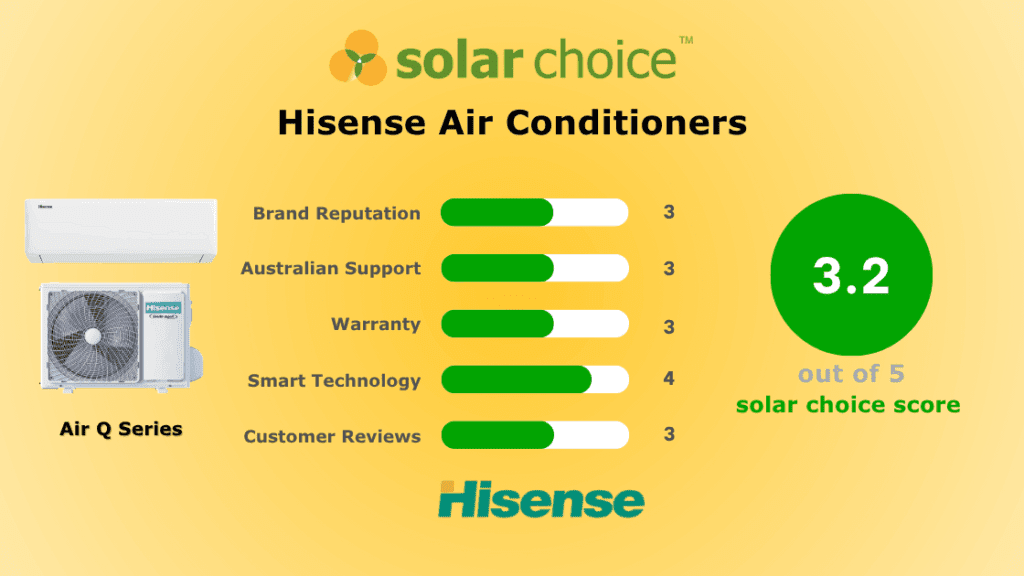Solar Choice is not affiliated with Hisense air conditioners or any other manufacturer. This review is independent and unbiased.
At a Glance: Hisense Scores 3.2 out of 5
Hisense offers three split-system ranges in Australia — Eros, Air Q and Energy Pro — designed for homeowners seeking affordable, Wi-Fi enabled units with solid cooling performance. While not a specialist HVAC manufacturer, the brand delivers competitive features, quiet operation and good value for money, particularly in smaller capacities.
Solar Choice has developed a transparent air conditioner scorecard to rank all brands in the Australian market:
Brand Reputation & Reliability (3/5): Hisense has a moderate reliability record in Australia, with mixed feedback from installers and consumers.
Australian Presence & Support Infrastructure (3/5): The company maintains a local office and service partners, but coverage is stronger in metro areas than regional.
Warranty Strength & Transparency (3/5): A standard 5-year parts and labour warranty with clear terms aligns with the industry average.
Innovation & Smart Technology (4/5): Hisense includes Wi-Fi, app control and voice assistant compatibility across major ranges, outperforming most budget-tier brands.
Customer Satisfaction & Review Consistency (3/5): Review scores typically fall in the mid-3 to low-4 star range, indicating generally good experiences but occasional support challenges.
Overall summary: Hisense offers strong value and excellent cooling efficiency in the Air Q range, but heating performance and long-term durability trail established premium brands.
Compare quotes from local, reputable Air Con installers
Hisense Company Background & Australian Presence
Hisense is a global electronics manufacturer based in China with over 50 years of consumer technology experience. In Australia, Hisense is best known for TVs and appliances, but the company has expanded steadily into air conditioning over the past decade.
While not as specialised as Daikin or Mitsubishi Electric, Hisense offers competitive feature sets and strong cooling performance at accessible prices. Local customer service and warranty support are handled through the company’s Australian office and authorised service partners.
Hisense generally appeals to value-focused households in warm or mild climates looking for affordable, Wi-Fi-enabled split systems.
Air Conditioner Range, Efficiency & Performance
Hisense offers three wall-mounted reverse-cycle split-system ranges in Australia — Eros, Air Q, and Energy Pro. The key differences between the ranges relate to cooling efficiency, noise levels, smart features and value. The Air Q Series is the highest-performing option, delivering excellent cooling star ratings and very low indoor noise. Energy Pro sits in the mid-range with balanced performance, while Eros offers an affordable entry point for smaller and medium-sized rooms. All models use R32 refrigerant, a more efficient and lower-impact cooling as along with inverter compressors and Wi-Fi app control.
The tables below summarise the current Hisense wall split systems available in Australia, with capacity, star ratings and indoor noise (silent mode) shown consistently across the range.
Eros Series (HAWJ)

The Hisense Eros Series is the most affordable option in the lineup, offering basic smart features and reliable cooling performance. Star ratings and heating efficiency are more modest than Hisense’s premium series, making Eros better suited to smaller rooms and cooling-dominant homes in warm or mild climates.
| Model | Power Capacity | Efficiency Star Rating* | Indoor Noise (Silent) |
How It Compares |
|---|---|---|---|---|
| HAWJ9KR | 2.5 kW Cool 3.1 kW Heat |
4 ★ Cool 3 ★ Heat |
25 dB | Above-average cooling efficiency in the budget tier. |
| HAWJ12KR | 3.5 kW Cool 3.8 kW Heat |
3.5 ★ Cool 2.5 ★ Heat |
25 dB | Typical performance for this size; premium brands achieve higher heating efficiency. |
| HAWJ18KR | 5.3 kW Cool 5.4 kW Heat |
2.5 ★ Cool 2 ★ Heat |
32 dB | Lower efficiency compared with other 5 kW-class units. |
| HAWJ24KR | 7.1 kW Cool 7.2 kW Heat |
3.5 ★ Cool 2 ★ Heat |
32 dB | Strong cooling output; heating performance is modest. |
| HAWJ28KR | 8.0 kW Cool 8.0 kW Heat |
3 ★ Cool 2.5 ★ Heat |
32 dB | Suitable for large rooms but less efficient than mid-range competitors. |
Air Q Series (HAWU)

Air Q is Hisense’s highest-efficiency range, offering excellent cooling performance across smaller and medium-sized capacities. With very low noise levels and strong cooling star ratings, these models suit bedrooms, studies and living areas where quiet operation and low running costs are priorities.
| Model | Power Capacity | Efficiency Star Rating* | Indoor Noise (Silent) |
How It Compares |
|---|---|---|---|---|
| HAWU9KR | 2.5 kW Cool 3.2 kW Heat |
7 ★ Cool 3 ★ Heat |
19 dB | One of the strongest value 2.5 kW units in Australia for cooling efficiency. |
| HAWU12KR | 3.7 kW Cool 3.9 kW Heat |
5.5 ★ Cool 3 ★ Heat |
19 dB | Comparable to reputable mid-range brands in cooling efficiency. |
| HAWU18KR | 5.1 kW Cool 5.8 kW Heat |
4.5 ★ Cool 2.5 ★ Heat |
25 dB | Very efficient for cooling; heating performance is average. |
| HAWU24KR | 7.2 kW Cool 8.0 kW Heat |
4 ★ Cool 2.5 ★ Heat |
32 dB | Good cooling performance for large rooms; heating stars remain modest. |
| HAWU28KR | 8.0 kW Cool 8.5 kW Heat |
2.5 ★ Cool 2 ★ Heat |
32 dB | Best suited for cooling-dominant environments; low heating star rating. |
Energy Pro Series (HAWG)

Energy Pro models offer balanced performance and value, sitting between Eros and Air Q. They deliver respectable cooling star ratings and moderate heating efficiency. These units work well in medium and large rooms where cooling performance matters more than heating output.
| Model | Power Capacity | Efficiency Star Rating* | Indoor Noise (Silent) |
How It Compares |
|---|---|---|---|---|
| HAWG9KR | 2.5 kW Cool 3.2 kW Heat |
4.5 ★ Cool 3 ★ Heat |
25 dB | A strong budget-to-mid-range option with balanced performance. |
| HAWG12KR | 3.5 kW Cool 3.7 kW Heat |
4 ★ Cool 3 ★ Heat |
25 dB | Good overall balance of cooling and heating for small living areas. |
| HAWG18KR | 5.0 kW Cool 5.3 kW Heat |
4 ★ Cool 3 ★ Heat |
32 dB | Competitive cooling efficiency for the 5 kW category. |
| HAWG24KR | 7.2 kW Cool 7.5 kW Heat |
3.5 ★ Cool 2.5 ★ Heat |
32 dB | Reasonable cooling performance for larger rooms; moderate heating efficiency. |
| HAWG28KR | 8.0 kW Cool 8.0 kW Heat |
3 ★ Cool 2.5 ★ Heat |
32 dB | Works well for cooling larger areas; heating performance trails premium brands. |
How the Three Series Compare Overall
- Best efficiency: Air Q (especially 2.5–3.7 kW models)
- Best value: Eros (smaller rooms)
- Best for medium/large rooms: Energy Pro
Compare quotes from local, reputable Air Con installers
Other Hisense Options
Multi-Head Systems

Hisense offers outdoor units supporting 2–5 indoor heads, compatible with wall splits, bulkheads and compact ducted units. These suit apartments or multi-room homes needing independent temperature control. Efficiency varies depending on the indoor combination.
Ducted & Cassette Systems
Hisense compact ducted units and ceiling cassettes are suited to small commercial spaces or modern residential renovations. They offer basic zoning flexibility but fewer advanced airflow controls than premium ducted brands.
How Much Does a Hisense Split System Cost?
Hisense positions itself at the budget to mid-range end of the market, with pricing that is generally lower than Panasonic, Mitsubishi Electric or Daikin but above ultra-budget retailers. Installation costs depend on unit size, pipe length, wall type and whether switchboard upgrades are required.
Typical supply-only pricing:
- 2.5–3.5 kW: $1,000–$1,500
- 5.0–5.3 kW: $1,400–$1,900
- 7.0–8.0 kW: $1,800–$2,500
Typical fully installed pricing (standard back-to-back install with ≤3 m pipe):
- 2.5–3.5 kW: $1,800–$2,400 installed
- 5.0–5.3 kW: $2,400–$3,200 installed
- 7.0–8.0 kW: $3,200–$4,500 installed
Additional installation costs apply for second-storey work, long pipe runs, roof-mounted condensers, complex wiring paths, or older switchboards requiring upgrades.
Hisense systems are also eligible for state energy-efficiency rebates such as the NSW Energy Savings Scheme, the VIC Energy Upgrade discount and the SA REPS Scheme, which can significantly reduce upfront installation costs.
Learn about Air Conditioner running costs.
Hisense Warranty Offer for Australian Customers
Hisense provides a 5-year parts and labour warranty for residential air conditioners purchased in Australia. This is the standard coverage offered by most mid-market brands and applies when the unit is installed by a licensed electrician (and plumber where required). The warranty covers defects in materials and workmanship but does not extend to installation errors, misuse, vermin, corrosion or operation outside recommended conditions.
Key Conditions
- Proof of purchase and licensed installation required
- Serial number must remain intact
- Accessories such as remotes and filters are covered for 12 months
- Warranty is non-transferable
Service Coverage
Repairs are handled through Hisense’s authorised Australian service partners. Service coverage is strongest in metropolitan areas; customers in regional zones may incur additional travel costs. Hisense does not provide loan units during repairs.
Exclusions
The warranty does not cover:
- Damage from incorrect installation
- Environmental damage (e.g. corrosion, vermin)
- Power surges
- Commercial use unless approved
- Consumables (filters, remote batteries)
This warranty operates alongside consumer rights under the Australian Consumer Law, which guarantee a repair, replacement or refund for major failures. More details can be found at consumer.gov.au and the ACCC’s appliance guidance pages.
Read Hisense’s full warranty terms.
Pros & Cons
| Pros | Cons |
|---|---|
| ✔ Very strong cooling efficiency in Air Q series | ✘ Heating efficiency modest, especially in larger models |
| ✔ Quiet operation (down to 19 dB) | ✘ Long-term durability less established than premium brands |
| ✔ Competitive pricing with Wi-Fi included | ✘ Fewer advanced control features than specialist HVAC brands |
| ✔ Broad range covering small to large rooms | ✘ Service coverage varies outside metro areas |
Conclusion
Hisense’s Eros, Air Q and Energy Pro series provide Australian households with a broad selection of affordable, Wi-Fi enabled reverse-cycle split systems. Across the lineup, cooling performance in the smaller capacities is a clear strength, particularly in the Air Q series, and indoor noise levels are among the better results in the budget to mid-range category.
However, heating efficiency is modest across nearly all larger models, and Hisense does not yet demonstrate the long-term reliability or nationwide service infrastructure associated with specialist HVAC brands.
Our score of 3.2 places Hisense in the middle of the market. These systems suit households prioritising upfront affordability and strong cooling performance in mild or warm climates, but they may not be the best fit for homes that rely heavily on heating or where long-term durability and service depth are critical considerations.
For official star ratings and efficiency comparisons, see the Energy Rating Register or the Your Home Guide.
Compare quotes from local, reputable Air Con installers
- APsystems Battery Review: An Independent Assessment by Solar Choice - 18 December, 2025
- Running Cost of Air Conditioners – Explained - 7 October, 2025
- Air Conditioner Rebate South Australia: What You Need to Know - 19 September, 2025
